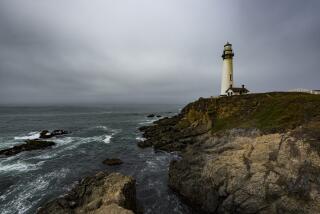Looking down on his British subjects
It’s a smallish island, mostly flat, prone to green fields under clouded skies. Not much surfing, unreliable sunbathing. So why devote a coffee-table book to Britain’s wet edges?
Because Britain’s coastal geography tells some startling tales. The British Isles may tend toward flatness and their skies toward grayness, but wherever land and sea meet, interesting things happen, especially if human beings have been putting things up and knocking them down for a few thousand years. So if you buzz around the fringes of England, Scotland, Wales and Northern Ireland, you see some striking sights, some made by nature, some otherwise.
This is what photographer Richard Cooke has done. Assigned by the Royal Mail to come up with coastal images for 10 new stamps, Cooke spent weeks in helicopters flying over sandy beaches, cliffs, castles, piers, mudflats, fishing fleets, tract homes and lighthouses.
Cooke didn’t cover all 7,000 miles of British shoreline -- that’s more than six times the length of California’s coast -- but he did come back with enough to fill this volume with 140 color photographs.
Most of the images were shot looking straight down, and the readers’ journey begins with the rooftops of tiny St. Ives, a fishing town in Cornwall, neighbored by a few dozen beached boats and the emerald sea. Soon after come the white cliffs of Dover -- not that you’d recognize the chalky abstraction as such without a caption. At the Isle of Wight, Cooke’s camera spots a set of pinnacles in the sea known as the Needles -- but from this angle, they look more like snake vertebrae.
Packed with these visual tricks, this book gives new dimension to a territory that most Americans know best for its language, culture and landlocked cityscapes.
*
The desire for adventure: Author asks, ‘Why?’
Hampton SIDES is an accomplished magazine guy, and these 30 chapters began as stories, some of them more than a decade ago, in publications as varied as Outside, Penthouse and the New Yorker.
They gain gravitas when placed side by side and shine a welcome light into the American landscape and the psychology of American travelers.
He bounces down the Colorado among river rats and bureaucrats when the feds stage an experimental flood.
He trespasses on the grounds of the exclusive Bohemian Club in the woods of Northern California and sits in among the fainting and hollering worshipers at the Church of God in Christ’s annual gathering in Memphis, Tenn.
As for the traveler’s psychology, I direct readers to a splendid pair of pieces that stand together like alternate faces of a coin.
First, the author falls in with the Silver City, an organized subculture of itinerant senior citizens that surrounds the shiny, curvy Airstream trailer. (Airstreamers hate hail, Sides notes, because it leaves little pockmarks on the trailers’ aluminum skins, an affliction known as “airstream acne.”)
Then he wades into the motorcycles and madness that make up the annual Harley-Davidson riders’ pilgrimage to Sturgis, S.D. Roger Miller turns up to sing “King of the Road” for the first group; Steppenwolf tears into “Born to Be Wild” for the second.
In the course of that first story, Sides sidles up to a retired engineer and Airstream devotee named Frank Sargent, who offers an observation that applies equally to the trailer-draggers, the Harley crowd and who knows how many other Americans with itchy feet and communitarian leanings.
“Why do people go caravanning?” Sargent asks Sides rhetorically. “It’s elemental. The nomadic instinct is something deep inside us. It’s as old and powerful as our need to stare into an open fire. People for thousands of generations have moved in caravans. Gadding around in groups is part of what we are. It fulfills the tribal instinct.”
Here and there, as he explores American subcultures, Sides’ tone slips dangerously close to mockery, and every once in a while he relies too heavily on brand names to do his descriptive work for him. (How helpful is it, for instance, to know that some Airstreamers sit in Zip Dee lawn chairs?)
But mostly, he sees clearly into under-examined corners of our culture. And he writes with zing. Here he is at the bottom of the Grand Canyon:
“All the river-running advice in the world cannot adequately prepare me for my first encounter with truly gigantic white water: the basso profundo rumble, the fugues of froth, the million watery rhythms bombarding the senses. I’m standing on a promontory above a monster rapid called Hance, feeling the mist rising off the water, smelling the turbid river smells.”
More to Read
Sign up for our Book Club newsletter
Get the latest news, events and more from the Los Angeles Times Book Club, and help us get L.A. reading and talking.
You may occasionally receive promotional content from the Los Angeles Times.







